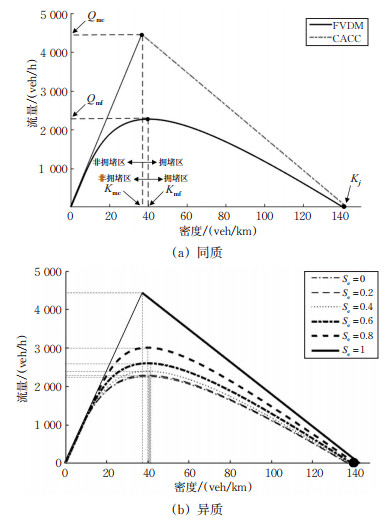Fundamental Diagram and Stability Analysis of Heterogeneous Traffic Flow in a Connected and Autonomous Environment
-
摘要:
为研究人工驾驶车辆和智能网联车辆(CAVs)的混合运行对交通流产生的影响,以其基本图和稳定性为突破口研究提高异质交通流运行效率的关键技术与方法。选择全速度差模型(FVDM)作为人工驾驶车辆跟驰模型,将加州伯克利分校实车数据标定的协同自适应巡航控制(CACC)模型作为CAVs跟驰模型。建立了异质交通流基本图模型,研究了CACC车辆的混入对道路通行能力的影响;对比了不同人工驾驶模型对异质流通行能力产生的差异性。从大车-小车组成的传统异质交通流研究方法入手,利用跟驰模型建立人工-网联异质流的稳定性解析方法,并运用Matlab验证了不同CACC比例下的稳定性分析。结果表明:与人工驾驶交通流相比,CACC同质交通流的道路通行能力大约提升了95%;实验中选用不同人工驾驶模型对通行能力实验结果造成的差异不大。平衡态速度为15 m/s时,低比例CAVs(如低于20%)并不能改善交通流;当CAVs比例达到20%及以上时,异质流稳定性随着CAVs的比例增加逐渐呈现出稳定趋势;当CAVs比例达到70%以上时,异质流基本稳定。
Abstract:This work focuses on the impacts of heterogeneous operation of manual driving vehicles and connected and autonomous vehicles(CAVs)on traffic flow. The fundamental diagram and stability of such traffic flow are set as the key technologies and methods to improve its operation. First, the full velocity difference model(FVDM)is selected as the car-following model of manual driving vehicles. Secondly, the cooperative adaptive cruise control(CACC)model calibrated with real-world vehicle location data from the University of California at Berkeley is used as the car-follow⁃ ing model of CAVs. Third, a fundamental diagram model of heterogeneous traffic flow is then developed to study the influence of CACC vehicles on road capacity and to compare the impacts of different manual driving models on hetero⁃ geneous flow capacity. In addition, based on the traditional research method of heterogeneous traffic flow consisting of vehicles of different sizes, the traditional car-following model is used to develop a stability analysis method for the het⁃ erogeneous traffic flow under study, and the stability analysis under different CACC ratios is carried out by Matlab. Study results confirms that, compared with the homogeneous manual-driving traffic flow, the road capacity under the homogeneous CACC traffic flow will be increased by about 95% and different manual driving models in the experiment has little impact onto the capacity. When the equilibrium speed is set at 15 m/s, a low proportion of CAVs(e.g. below 20%)won't improve the stability of traffic flow. On the other hand, when the proportion of CAVs reaches 20% and above, the heterogeneous flow gradually shows an increasing stable trend with an increased proportion of CAVs. It is al⁃ so found that, when the proportion of CAVs reaches 70% and above, traffic flow basically will maintain its stability.
-
表 1 异质交通流的构成解析
Table 1. Analysis of the composition of heterogeneous traffic flow
序号 后车 前车 概率 退化后的跟随情况 1 人工驾驶车辆 人工驾驶车辆 SmSm 人工车辆跟随人工车辆 2 人工驾驶车辆 CACC车辆 SmSc 人工车辆跟随CACC车辆 3 CACC车辆 人工驾驶车辆 ScSm 人工车辆跟随人工车辆 4 CACC车辆 CACC车辆 Sc Sc CACC车辆跟随CACC车辆 注:Sm为人工驾驶车辆的实际数量比例,Sc为CACC车辆的实际数量比例(Sm + Sc = 1,Sm和Sc均在0~1之间)。 表 2 异质交通流的通行能力
Table 2. Capacity of heterogeneous traffic flow
CACC车辆比例Sc FVDM计算值/(veh/h) IDM计算值/(veh/h) 0 2 262 1 837 0.2 2 294 2 044 0.4 2 397 2 311 0.6 2 604 2 670 0.8 3 010 3 200 1 4 435 4 445 表 3 异质交通流稳定性分析
Table 3. Stability analysis of heterogeneous traffic flow
CACC车辆比例Sc 稳定性计算值 稳定性上升值 0 -0.353 0 -- 0.1 -0.347 9 0.005 1 0.2 -0.332 6 0.015 3 0.3 -0.307 0 0.025 6 0.4 -0.271 3 0.035 7 0.5 -0.2253 0.046 0 0.6 -0.169 1 0.056 2 0.7 -0.102 7 0.066 4 0.8 -0.026 1 0.077 6 0.9 0.060 7 0.086 8 1 0.157 8 0.097 1 -
[1] SHLADOVER S E, NOWAKOWSKI C, LU X Y, et al. Cooperative adaptive cruise control: Definitions and operating concepts[J]. Transportation Research Record: Journal of the Transportation Research Board, 2016, 2489(1): 145-152. http://docs.trb.org/prp/15-3265.pdf [2] 金春霞, 王慧. 跟车模型及其稳定性分析综述[J]. 交通运输系统工程与信息, 2001, 1(3): 220-225. doi: 10.3969/j.issn.1009-6744.2001.03.010JIN Chunxia, WANG Hui. Car-following model and its stability analysis[J]. Journal of Transportation Systems Engineering and Information Technology, 2001, 1(3): 220-225. (in Chinese) doi: 10.3969/j.issn.1009-6744.2001.03.010 [3] 杨龙海, 张春, 仇晓赟, 等. 车辆跟驰模型研究进展[J]. 交通运输工程学报, 2019, 19(5): 125-138. https://www.cnki.com.cn/Article/CJFDTOTAL-JYGC201905015.htmYANG Longhai, ZHANG Chun, QIU Xiaofu, et al. Research progress on car following models[J]. Journal of Traffic and Transportation Engineering, 2019, 19(5): 125-138. (in Chinese) https://www.cnki.com.cn/Article/CJFDTOTAL-JYGC201905015.htm [4] ZHU W X, ZHANG H M. Analysis of mixed traffic flow with human-driving and autonomous cars based on car-following model[J]. Physica A: Statal Mechanics and Its Applications, 2018(496): 274-285. http://smartsearch.nstl.gov.cn/paper_detail.html?id=168587d0141bfa94e529cd33d8f47723 [5] ARNAOUT G M, ARNAOUT J P. Exploring the effects of cooperative adaptive cruise control on highway traffic flow using microscopic traffic simulation[J]. Transportation Planning and Technology, 2014, 37(2): 186-199. doi: 10.1080/03081060.2013.870791 [6] SHLADOVER S, SU D Y, LU X Y. Impacts of cooperative adaptive cruise control on freeway traffic flow[J]. Transportation Research Record: Journal of the Transportation Research Board, 2012, 2324(1): 63-70. doi: 10.3141/2324-08 [7] 秦严严, 王昊, 王炜, 等. 混有CACC车辆和ACC车辆的异质交通流基本图模型[J]. 中国公路学报, 2017, 30(10): 127-136. https://www.cnki.com.cn/Article/CJFDTOTAL-ZGGL201710016.htmQIN Yanyan, WANG Hao, WANG Wei, et al. Fundamental diagram model of heterogeneous traffic flow mixed with cooperative adaptive cruise control vehicles and adaptive cruise control vehicles[J]. China Journal of Highway and Transport, 2017, 30(10): 127-136. (in Chinese) https://www.cnki.com.cn/Article/CJFDTOTAL-ZGGL201710016.htm [8] 董长印, 王昊, 王炜, 等. 混入智能车的下匝道瓶颈路段交通流建模与仿真分析[J]. 物理学报, 2018, 67(14): 179-193. https://www.cnki.com.cn/Article/CJFDTOTAL-WLXB201814020.htmDONG Changyin, WANG Hao, WANG Wei, et al. Hybrid traffic flow model for intelligent vehicles exiting to off-ramp[J]. Acta Physica Sinica, 2018, 67(14): 179-193. (in Chinese) https://www.cnki.com.cn/Article/CJFDTOTAL-WLXB201814020.htm [9] GE J I, OROSZ G. Dynamics of connected vehicle systems with delayed acceleration feedback[J]. Transportation Research Part C: Emerging Technologies, 2014, 46(9): 46-64. http://www.sciencedirect.com/science/article/pii/S0968090X14001119 [10] MILANÉS V, SHLADOVER S E. Modeling cooperative and autonomous adaptive cruise control dynamic responses using experimental data[J]. Transportation Research Part C: Emerging Technologies, 2014(48): 285-300. http://www.onacademic.com/detail/journal_1000036656393210_d25c.html [11] GU H Y, ZHANG J, JIN J, et al. Stability analysis of lead-vehicle control model in cooperative adaptive cruise control platoon within heterogeneous traffic flow[J]. Journal of Southeast University(English Edition), 2018, 34(3): 386-393. http://www.researchgate.net/publication/328552149_Stability_analysis_of_lead-vehicle_control_model_in_cooperative_adaptive_cruise_control_platoon_within_heterogeneous_traffic_flow [12] 杨达, 祝俪菱, 蒲云, 等. 两种驾驶方式构成的异质交通流稳定性研究[J]. 北京理工大学学报, 2013, 33(11): 1140-1144. doi: 10.3969/j.issn.1001-0645.2013.11.008YANG Da, ZHU Liling, PU Yun, et al. Stability analysis of the heterogeneous traffic flow mixed by two driving styles[J]. Transaction of Beijing Institute of Technology, 2013, 33(11): 1140-1144. (in Chinese) doi: 10.3969/j.issn.1001-0645.2013.11.008 [13] 王昊, 秦严严. 网联车混合交通流渐进稳定性解析方法[J]. 哈尔滨工业大学学报, 2019, 51(3): 88-91. https://www.cnki.com.cn/Article/CJFDTOTAL-HEBX201903013.htmWANG Hao, QIN Yanyan. Asymptotic stability analysis of traffic flow mixed with connected vehicles[J]. Journal of Harbin Institute of Technology, 2019, 51(3): 88-91. (in Chinese) https://www.cnki.com.cn/Article/CJFDTOTAL-HEBX201903013.htm [14] XIE D F, ZHAO X M, HE Z B. Heterogeneous traffic mixing regular and connected vehicles: Modeling and stabilization[J]. IEEE Transactions on Intelligent Transportation Systems, 2019, 20(6): 2060-2071. doi: 10.1109/TITS.2018.2857465 [15] 徐桃让, 姚志洪, 蒋阳升, 等. 智能网联车环境下考虑反应时间影响的基本图模型[J]. 公路交通科技, 2020, 37(8): 108-117. https://www.cnki.com.cn/Article/CJFDTOTAL-GLJK202008014.htmXU Taorang, YAO Zhihong, JIANG Yangsheng, et al. Fundamental diagram model of considering reaction time in environment of intelligent connected vehicles[J]. Journal of Highway and Transportation Research and Development, 2020, 37(8): 108-117. (in Chinese) https://www.cnki.com.cn/Article/CJFDTOTAL-GLJK202008014.htm [16] 杨龙海, 赵顺, 徐洪. 基于改进优化速度函数的跟驰模型研究[J]. 交通运输系统工程与信息, 2017, 17(2): 41-46. https://www.cnki.com.cn/Article/CJFDTOTAL-YSXT201702007.htmYANG Longhai, ZHAO Shun, XU Hong. Car-following model based on the modified optimal velocity function[J]. Journal of Transportation Systems Engineering and Information Technology, 2017, 17(2): 41-46. (in Chinese) https://www.cnki.com.cn/Article/CJFDTOTAL-YSXT201702007.htm [17] 刘大为, 史忠科. 基于侧向车辆影响的跟驰模型建模及仿真[J]. 交通信息与安全, 2019, 37(1): 35-41. https://www.cnki.com.cn/Article/CJFDTOTAL-JTJS201901007.htmLIU Dawei, SHI Zhongke. Modeling and simulation of a car-following model based on influences of lateral vehicles[J]. Journal of Transport Information and Safety, 2019, 37(1): 35-41. (in Chinese) https://www.cnki.com.cn/Article/CJFDTOTAL-JTJS201901007.htm [18] JIANG R, WU Q S, ZHU Z J. Full velocity difference model for a car-following theory[J]. Physical Review E: Statistical, Nonlinear, and Soft Matter Physics, 2001, 64(1): 017101. http://or.nsfc.gov.cn/bitstream/00001903-5/866/1/1000000792166.pdf [19] JIANG R, WU Q S. First-and second-order phase transitions from free flow to synchronized flow[J]. Physica A: Statistical Mechanics and Its Applications, 2003(322): 676-684. http://www.onacademic.com/detail/journal_1000034194771010_b9b0.html [20] WANG H, WANG W, CHEN J, et al. Can we trust the speed-spacing relationship estimated by car-following model from non-stationary trajectory data?[J]. Transportmetrica A Transport Science, 2018, 15(2): 263-284. http://www.onacademic.com/detail/journal_1000040285192110_63c4.html [21] 秦严严, 王昊, 王炜. 网联辅助驾驶混合交通流稳定性及安全性分析[J]. 东南大学学报(自然科学版), 2018, 48(1): 188-194. https://www.cnki.com.cn/Article/CJFDTOTAL-DNDX201801029.htmQIN Yanyan, WANG Hao, WANG Wei. Analysis on stability and safety for mixed traffic flow with connected auxiliary driving[J]. Journal of Southeast University(Natural Science Edition), 2018, 48(1): 188-194. (in Chinese) https://www.cnki.com.cn/Article/CJFDTOTAL-DNDX201801029.htm [22] 王祺, 谢娜, 侯德藻, 等. 自适应巡航及协同式巡航对交通流的影响分析[J]. 中国公路学报, 2019, 32(6): 188-197. https://www.cnki.com.cn/Article/CJFDTOTAL-ZGGL201906020.htmWANG Qi, XIE Na, HOU Dezao, et al. Effects of adaptive cruise control and cooperative adaptive cruise control on traffic flow[J]. China Journal of Highway and Transport, 2019, 32(6): 188-197. (in Chinese) https://www.cnki.com.cn/Article/CJFDTOTAL-ZGGL201906020.htm [23] PLOEG J, SEMSAR-KAZEROONI E, LIJSTER G, et al. Graceful degradation of cooperative adaptive cruise control[J]. IEEE Transactions on Intelligent Transportation Systems, 2015, 16(1): 488-497. http://ieeexplore.ieee.org/iel7/6979/7027907/06907977.pdf [24] 秦严严, 王昊, 王炜, 等. 混有协同自适应巡航控制车辆的异质交通流稳定性解析与基本图模型[J]. 物理学报, 2017, 66(9): 257-265. https://www.cnki.com.cn/Article/CJFDTOTAL-WLXB201709027.htmQIN Yanyan, WANG Hao, WANG Wei, et al. Stability analysis and fundamental diagram of heterogeneous traffic flow mixed with cooperative adaptive cruise control vehicles[J]. Acta Physica Sinica, 2017, 66(9): 257-265. (in Chinese) https://www.cnki.com.cn/Article/CJFDTOTAL-WLXB201709027.htm [25] WILSON R E. Mechanisms for spatio-temporal pattern formation in highway traffic models[J]. Philosophical Transactions of the Royal Society A: Mathematical, Physical and Engineering Sciences, 2008, 366(1872): 2017-2032. [26] WARD J A. Heterogeneity, lane-changing and instability in traffic: A mathematical approach[D]. Bristol: University of Bristol, 2009. -





 下载:
下载:



